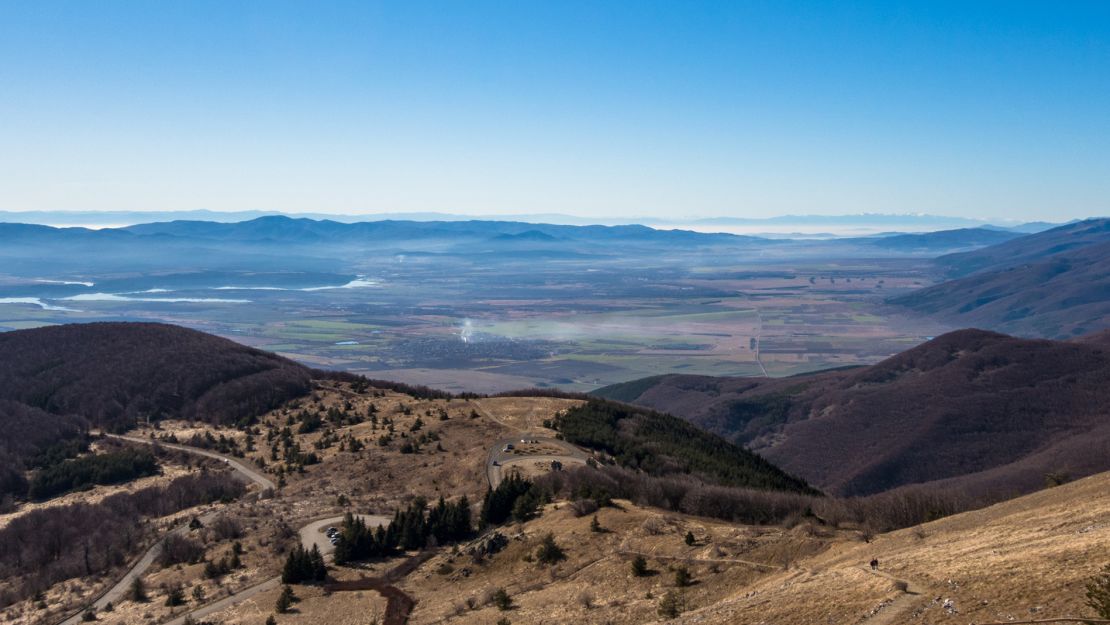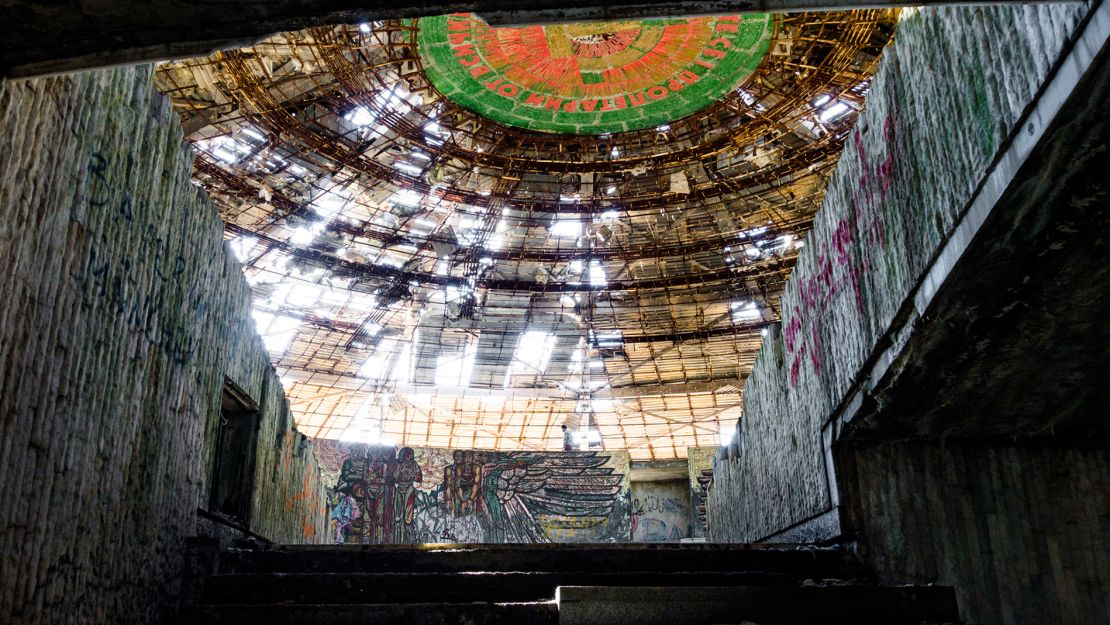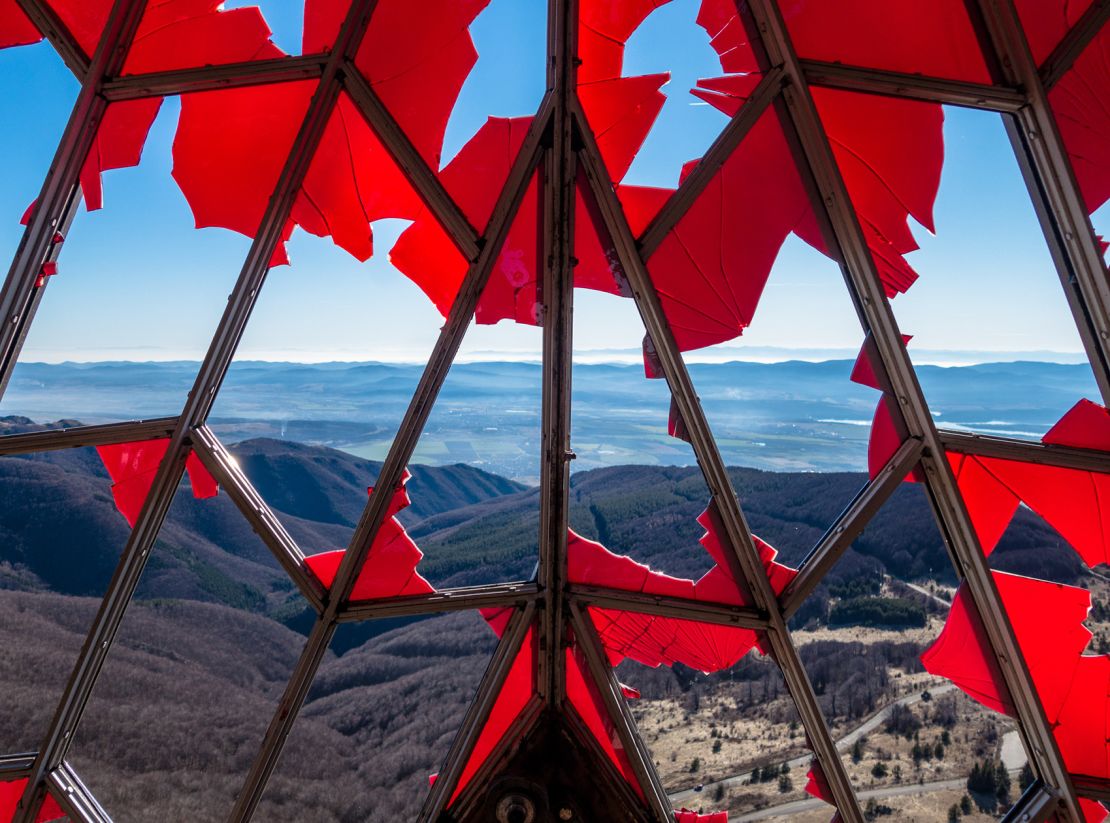Story highlights
Bulgaria's Buzludzha Monument has been attracting urban explorers since the mid-90s
The spaceship-like monument is covered with original and new slogans, mosaic and graffiti
Three hours from Sofia, in the heart of the Balkan Mountains, a potholed road twists its way up Mount Buzludzha, leading to “Bulgaria’s UFO.”
Rising from the top of the hill, this perplexing concrete structure can be seen for kilometers, inspiring an anxious excitement in those laying eyes on it for the first time.
A red star, the symbol for communism, glares over the valley from the top of its 70-meter-high tower. The expansive, spaceship-like base is straight out of an early science fiction movie.
The UFO reference is justified.
Officially named the House-Monument of the Bulgarian Communist Party, but better known as the “Buzludzha Monument,” it’s been attracting urban explorers from around the world since the mid-1990s.
While hundreds of abandoned communist memorials are scattered all over the Balkans, few hold quite as much intrigue.
A journey to the Buzludzha Monument passes through picturesque farmlands and bucolic villages. With no public transport connecting this part of Bulgaria, a visitor’s only option is to make their own way there.
MORE: Inside one of the world’s largest caves
Battle zone

The Buzludzha Monument wasn’t placed at random. Its location in the middle of the Shipka Pass witnessed a series of famous battles between Bulgarian rebels and the Ottoman Empire in 1868.
Years later during the Russo-Turkish War from 1877-78 a small army finally overthrew the Ottomans on Mount Buzludzha, leading to Bulgaria’s independence.
Later, on August 2, 1891, a group of men met on the peak to create the Bulgarian Social Democratic Workers’ Party, which later became the Bulgarian Communist Party.
The historical significance of the site led the government to approve a large memorial to celebrate Bulgaria’s communist progression. In 1981, after nearly eight years of construction, the Buzludzha Monument was unveiled.
The giant monument was open to the public and used for official parties and events until the collapse of the Soviet Union resulted in its closure in 1989.
Left to the elements, it only took a few years without maintenance for it to fall into disrepair. Today, rising numbers of intrepid travelers make the pilgrimage to explore this rotting shrine to communism.
Graffiti covers the exterior, with slogans like “never forget your past” and “enjoy communism” painted by the entrance, which has been bolted shut for years.
READ: Former concentration camp turned into luxury resort
Solemn Hall

A circuit around the outside of the enormous, cylindrical building eventually leads to a hole high in the concrete.
Here, at their own risk, it’s possible for intruders to climb cautiously over a precarious drop and get access to the inside of the Buzludzha Monument.
The interior is eerie and foreboding. Litter and debris lie scattered across the floor and every footstep echoes off the decaying walls.
A broken staircase leads to the huge auditorium, originally named Solemn Hall.
The circular room is surrounded by over 500 square meters of intricate mosaics. The faces of famous Bulgarian politicians, as well as Engels, Marx and Lenin, keep watch over the hall.
The roof has been rapidly collapsing over the years, allowing rain, snow and light to penetrate into the building.
The center of the ceiling holds another huge mosaic of the iconic hammer and sickle emblem. In time, it may also come crashing down.
Above the hall is the outer ring, with more mosaics and views over the Shipka Pass. Moving deeper into the heart of the monument leads to a series of tunnels and service rooms, often choked with rainwater, rubble and spider webs.
Further exploration follows corroded pipes down a narrow passage that heads towards the soaring tower. Towards the end an old shaft rises vertically into the unknown while, hidden to the left, are ladders and steps ascending upwards.
This is where the darkness begins.
Armed with a torch and navigating by blind groping, it’s possible to scramble up the rusted ladders into the depths of the tower. Level after level passes by before the ladders make way for steep iron stairs.
MORE: China opens a communist theme park
Dying relic

Red-tinted daylight eventually begins to fill the space, filtering in from the damaged communist stars above.
Jagged shards of glass are everywhere, having been smashed out by looters reputedly told the stars were made of rubies.
Decrepit ventilation systems line the upper levels before the final breach through a steel manhole allows access to the exposed top of the tower.
The vistas over the Balkan Mountains are sensational and, for those without a fear of heights, climbing the aged and fragile scaffolding and onto the edge of the tower’s wall is an exhilarating experience.
Those with energy left to burn on the descent can stop by the two iron fists clutching torches at the bottom of Mount Buzludzha, then head towards the nearby Shipka Memorial, dedicated to the battles that took place in the past.
For a more cultural affair, the Shipka Memorial Church with its Russian Orthodox architecture is a worthy stopover before the return to Sofia or the energetic city of Plovdiv.
The future of the Buzludzha Monument is unknown. Security guards have been monitoring the property in recent months, refusing access to those who try to break inside.
Many people argue that it should be turned into a museum, and there are plans to create a restoration project that would see the existence of the structure saved.
For now the monument remains on top of Mount Buzludzha, wasting away as a dying relic to the Balkan’s tragic communist past.
Whether it’s restored or left to decay the intrigue of Bulgaria’s UFO will continue to attract urban explorers for many years to come.
READ: The extraordinary world of Soviet bus shelters
Crumbling monuments of the Soviet Union
Jarryd Salem is a freelance travel writer who has been searching for adventure and culture in off-the-beaten-path destinations since 2007. More of his stories and images can be found at NOMADasaurus.






























